

 |
Search the Site with

|
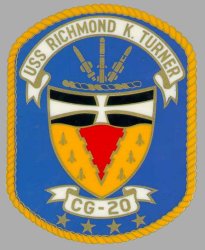 | 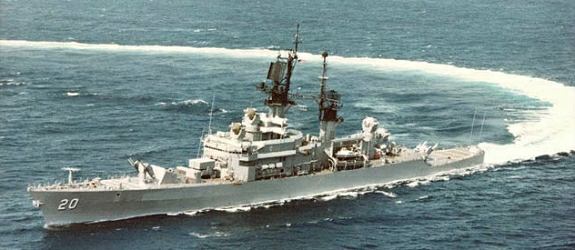 |
USS RICHMOND K. TURNER was the fifth ship in the LEAHY - class of "double-end" guided missile cruisers. USS RICHMOND K. TURNER was last homeported in Pascagoula, Miss., and on August 9, 1998, she was sunk as a target near Puerto Rico.
| General Characteristics: | Keel laid: January 9, 1961 |
| Launched: April 6, 1963 | |
| Commissioned: June 13, 1964 | |
| Decommissioned: April 13, 1995 | |
| Builder: New York Shipbuilding Corp., Camden, N.J. | |
| Propulsion system:4 - 1200 psi boilers; 2 General Electric geared turbines | |
| Propellers: two | |
| Length: 535 feet (163 meters) | |
| Beam: 53 feet (16.1 meters) | |
| Draft: 26 feet (7.9 meters) | |
| Displacement: approx. 7,800 tons | |
| Speed: 30+ knots | |
| Aircraft: none | |
| Armament: two Mk 141 | |
| Crew: 27 officers and 413 enlisted |
Crew List:
This section contains the names of sailors who served aboard USS RICHMOND K. TURNER. It is no official listing but contains the names of sailors who submitted their information.
USS RICHMOND K. TURNER Cruise Books:
USS RICHMOND K. TURNER History: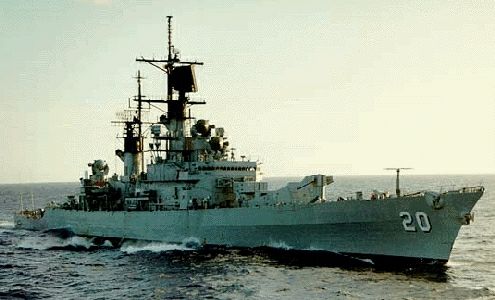 The keel of the USS RICHMOND K. TURNER was laid on January 9, 1961 by New York Shipbuilding Corp. at Camden, New Jersey. She was one of nine Leahy-class "double-ended" guided missile destroyers. She was launched on April 6, 1963 and commissioned on June 19, 1964 at the Philiadelphia Naval Shipyard, Capt. Douglas C. Plate in command.
The keel of the USS RICHMOND K. TURNER was laid on January 9, 1961 by New York Shipbuilding Corp. at Camden, New Jersey. She was one of nine Leahy-class "double-ended" guided missile destroyers. She was launched on April 6, 1963 and commissioned on June 19, 1964 at the Philiadelphia Naval Shipyard, Capt. Douglas C. Plate in command.
Departing the Philadelphia Naval Shipyard August 10, 1964 for her homeport of San Diego, Calif., she touched briefly at Yorktown and Norfolk, Va., and then at Guantanamo Bay, Cuba. Entering the Pacific via the Panama Canal, she steamed northward toward her homeport, with a call at Acapulco, Mexico. She arrived San Diego September 11.
Following shakedown out of San Diego March 19 - May 7, 1965, RICHMOND K. TURNER prepared for her first deployment to the western Pacific. Departing San Diego June 4, she joined Task Force 77 in the Tonkin Gulf-South China Sea area and served as missile support ship for the attack carriers CORAL SEA (CVA 43), INDEPENDENCE (CV 62), and ORISKANY (CV 34) while they conducted air strike operations in Southeast Asia.
In September, she was relieved of duties as missile support ship and reassigned to the Search and Rescue Destroyer Unit in the Tonkin Gulf. After participating in missions in which eight aviators were rescued through October 8, she departed Subic Bay November 30, and arrived San Diego December 18.
TURNER's subsequent deployments followed in the wake of her first WestPac voyage, with leave, upkeep, overhaul, and type training rounding out her periods in homeport. She stood out of San Diego October 15, 1966, bound a second time for Southeast Asian waters.
Returning to her homeport March 28, 1967, she punctuated her coastal operations with a midshipman training cruise to Pearl Harbor. Departing for her third tour off Vietnam June 10, 1968, she contributed to Fleet readiness in Asian waters until her December 19, return to San Diego. Leave and upkeep extended through January 20, 1969.
TURNER then assumed duty as ASW Schoolship in the southern California operating areas. In February, she conducted a SecNav guest cruise, and March 1, she commenced an extensive updating of her shipboard missile systems at the Naval Station San Diego. She then underwent training and further preparations for her fourth WestPac deployment, which commenced in January 1970.
She arrived in Yokosuka, Japan, March 4, and spent the next two months operating in the Sea of Japan. June found her off the coast of Vietnam, where she remained until late July. Stopping off at Guam and Pearl Harbor, she returned to San Diego in August, arriving on the 12th.
TURNER continued operations out of San Diego until March 22, 1971, when she embarked for Bath, Maine. She arrived at the Bath Iron Works April 27, and was decommissioned May 5, under a Navy wide program to enhance the anti-air warfare capability of major guided missile ships. TURNER was recommissioned at Bath Iron Works on May 17, 1972 as a guided missile cruiser getting the new designation CG 20.
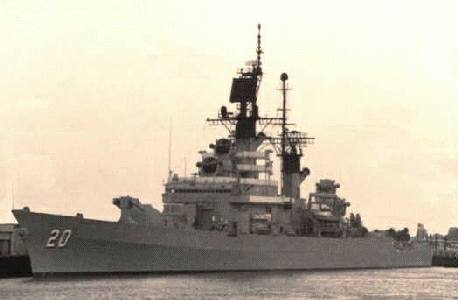 For the next seven months, TURNER engaged in various post modernization trials, exercises, and refresher training along the east coast of the United States and in the Caribbean. She returned to Newport, R.I., November 22, and remained there until January 9, 1973, when she entered Boston Naval Shipyard for a two-month yard period. Leaving Boston in March, TURNER deployed on a UNITAS cruise to South America in 1973, and participated in Operation 200 which included the International Naval Review in New York City on the occasion of the Nation's Bicentennial Celebration on July 4, 1976.
For the next seven months, TURNER engaged in various post modernization trials, exercises, and refresher training along the east coast of the United States and in the Caribbean. She returned to Newport, R.I., November 22, and remained there until January 9, 1973, when she entered Boston Naval Shipyard for a two-month yard period. Leaving Boston in March, TURNER deployed on a UNITAS cruise to South America in 1973, and participated in Operation 200 which included the International Naval Review in New York City on the occasion of the Nation's Bicentennial Celebration on July 4, 1976.
In May 1980 TURNER participate in Boston's OPSAIL 80, in addition to conducting two special operations for which she was awarded a Meritorious Unit Citation. RICHMOND K. TURNER completed four highly successful Mediterranean deployments as part of the U.S. Sixth Fleet, prior to an extensive baseline overhaul at Charleston Naval Shipyard, Charleston, SC from January to December 1982. During this overhaul TURNER received numerous updates which modernized her combat systems suite; this included the installation of the Vulcan Phalanx Close In Weapons System for self defense against cruise missiles. After this overhaul TURNER completed two more Mediterranean deployments, one of which included the successful launch of a Harpoon missile during a Gulf of Sidra operation.
TURNER also completed a 1988 deployment to the Persian Gulf and was a participant of Operation Earnest Will.
Upon her return to the United States, TURNER was overhauled in Ingalls Shipyard at Pascagoula, Mississippi,where she received the New Threat Upgrade (NTU) to her Combat Direction System as well as many engineering improvements.
In response to the crisis in the Persian Gulf caused by Iraq's invasion of Kuwait, RICHMOND K. TURNER deployed early as a primary AAW unit in the THEODORE ROOSEVELT (CVN 71) battle group, which arrived in the theater just before hostilities broke out.
During 60 days of operations in the Persian Gulf, TURNER provided protection to four carriers in the CV operating area and served as an advance picket ship in the mine infested waters off Kuwait in the final days of the war. Following the cease fire, TURNER relocated to the Red Sea where she participated in the continuing maritime interception operations in support of U.N. sanctions against Iraq.
Escorting USS THEODORE ROOSEVELT through the Suez Canal in late April '91, TURNER participated in Operation Provide Comfort, the massive relief effort to help tens of thousands of Kurdish refugees who fled the turmoil of Iraq following that country's decisive defeat in the war. During this time RICHMOND K. TURNER became the Anti-Air Warfare Commander for the Aircraft Carrier Striking Force, U.S. Sixth Fleet.
For her operations during this deployment, the Secretary of the Navy awarded RICHMOND K. TURNER the Joint Meritorious Service Medal, the Navy Unit Commendation, the National Defense Medal, and the Southwest Asia Service Medal.
RICHMOND K. TURNER's final years were marked by a final deployment to the Mediterranean as a part of the USS THEODORE ROOSEVELT battle group. She served with distinction as an anti-air warfare commander during Operation Deny Flight over the Former Republic of Yugoslavia and Bosnia.
Prior to her decommissioning on March 31, 1995, TURNER served as the test platform for the Navy's Light-weight Exoatmosheric Projectile (LEAP) Program, firing the first LEAP shot ever and launching the Navy into the future of missile technology.
On August 9, 1998, USS RICHMOND K. TURNER was sunk as a target near Puerto Rico. The SINKEX was condcuted by the USS ENTERPRISE battle group including the USS PHILIPPINE SEA (CG 58), USS THORN (DD 988), USS NICHOLSON (DD 982) and Carrier Air Wing 3.
About the Ship's Name: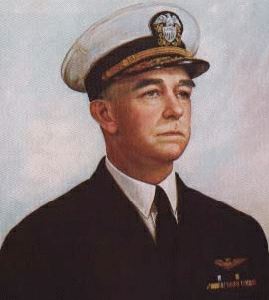 Admiral Richmond Kelly Turner was born in Portland, Oregon on May 27, 1885. He attended high school in Stockton, CA before his appointment to the U.S. Naval Academy. He graduated with distinction, fifth in a class of 201 in June 1908, and served the two years at sea, then required by law, before being commissioned Ensign in June 1910.
Admiral Richmond Kelly Turner was born in Portland, Oregon on May 27, 1885. He attended high school in Stockton, CA before his appointment to the U.S. Naval Academy. He graduated with distinction, fifth in a class of 201 in June 1908, and served the two years at sea, then required by law, before being commissioned Ensign in June 1910.
After graduation in 1908, Admiral Turner served consecutively in the USS MILWAUKEE, USS ACTIVE, USS PREBLE, and USS WEST VIRGINIA until June 1912, when he joined the USS STEWART, assuming command a year later. The World War I years found him aboard the battleships USS PENNSYLVANIA, USS MICHIGAN and USS MISSISSIPPI.
After serving as Commanding Officer of USS MERVINE, he reported for flight training at the Naval Air Station, Pensacola, Florida where he was designated a Naval Aviator on August 30, 1927 at the age of 42. Upon the completion of more than four and one half years of shore duty, Admiral Turner returned to sea Executive Officer of the aircraft carrier USS SARATOGA and subsequently Commanding Officer of the USS ASTORIA.
In October 1940, he became Director of the War Plans Division, Office of the Chief of Naval Operations.
In December 1941, he assumed additional duty as Assistant Chief of Staff of the Commander in Chief, U.S. Pacific Fleet. On July 19, 1942 he became Commander, Amphibious Force, South Pacific. From that time, he participated in most of the major amphibious engagements of the Pacific. Among Admiral Turner's most noteworthy achievements during the Pacific Campaign were the Guadalcanal-Tulagi invasion, the New Georgia campaign, the Tarawa assault, the occupation of the Marshall Islands and the seizure and occupation of Saipan.
So successful were Admiral Turner's amphibious operations throughout the Pacific theater, that he became known as the "Alligator", the symbol of fast and inexorable amphibious striking power. Besides the Navy Cross, he received the Distinguished Service Medal with three gold stars, the Navy Commendation Ribbon, the World War II Victory Medal, and the Philippine Liberation Ribbon. He was also made a Companion of the Order of the Bath by Great Britain.
Admiral Turner was transferred to the retired list of the Navy in the rank of Admiral on July 1, 1947. He died in Monterey, CA on February 12, 1961, shortly after the death of his wife, the former Miss Harriet Sterling, whom he had married 51 years before.
USS RICHMOND K. TURNER Image Gallery:
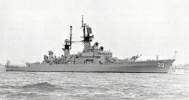 | 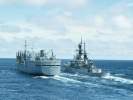 |
 Back to Cruisers list.
Back to Cruisers list.  Back to ships list.
Back to ships list.  Back to selection page.
Back to selection page.  Back to 1st page.
Back to 1st page.